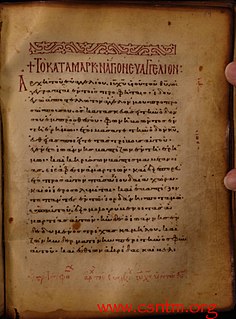Related Research Articles
Minuscule 2612, is a Greek minuscule manuscript of the New Testament, on 184 parchment leaves. Dated paleographically to the 13th century.

Minuscule 2614, is a Greek minuscule manuscript of the New Testament, dated paleographically to the 13th century.
Minuscule 2615, is a Greek minuscule manuscript of the New Testament, written on paper and parchment in a form of scroll.
Minuscule 2268, ε 2058, is a Greek minuscule manuscript of the New Testament. Paleographically it has been assigned to the 13th century. Only one leaf of the codex has survived.
Minuscule 2616, is a Greek minuscule manuscript of the New Testament, written on 280 parchment leaves. Paleographically it has been assigned to the 12th century.
Minuscule 2812, is a Greek minuscule manuscript of the New Testament, on 151 parchment leaves. It is dated paleographically to the 10th century.
Minuscule 2757, is a Greek minuscule manuscript of the New Testament, written on 266 parchment leaves. Palaeographically it has been assigned to the 12th century.
Minuscule 1780 δ 412, is a Greek minuscule manuscript of the New Testament, written on 198 parchment leaves. Paleografically it has been assigned to the 13th century.
Minuscule 2766, is a Greek minuscule manuscript of the New Testament, written on 147 parchment leaves. Paleographically it has been assigned to the 13th century.
Minuscule 2491, is a Greek minuscule manuscript of the New Testament, on 61 parchment leaves. It is dated paleographically to the 12th century. The text is written in one column per page, in 24 lines per page.
Codex Daltonianus, known as Minuscule 1423 (in the Gregory-Aland numbering), designated by A119 (in the Soden numbering), is a Greek minuscule manuscript of the New Testament, written on a paper. Palaeographically it had been assigned to the 14th century (or about 1200).
Minuscule 1813, designated by number 1813, ε 3047 (Soden), is a Greek minuscule manuscript of the New Testament, written on 235 parchment leaves. Paleografically it had been assigned to the 11th century.
Minuscule 119, ε 1290 (Soden), is a Greek minuscule manuscript of the New Testament, on parchment leaves. Palaeographically it has been assigned to the 13th century. It has complex contents with marginalia.
Minuscule 120, ε 1202 (Soden), is a Greek minuscule manuscript of the New Testament, on parchment leaves. Palaeographically it has been assigned to the 12th or 13th century. It has complex contents with some marginalia.
Minuscule 147, ε 401 (Soden), is a Greek minuscule manuscript of the New Testament, on parchment leaves. Palaeographically it has been assigned to the 13th century. Birch and F. H. A. Scrivener dated to the 11th century, C. R. Gregory dated to the 14th century.
Minuscule 392, Θε23 (Soden), is a Greek minuscule manuscript of the New Testament, on parchment. Paleographically it has been assigned to the 12th century. It has marginalia.

Minuscule 532, ε 255, is a Greek minuscule manuscript of the New Testament, on parchment. Palaeographically it has been assigned to the 12th century. Scrivener labeled it number 545. The manuscript was adapted for liturgical use. It is very incomplete, with many omissions and faded text along with much of it being missing because a missing manuscript contains some of the text.
Minuscule 533, ε 256, is a Greek minuscule manuscript of the New Testament, on a parchment, dated to the 13th century. It was adapted for liturgical use; marginalia are incomplete.
Minuscule 560, ε 1288, is a Greek minuscule manuscript of the New Testament, on parchment. Palaeographically it has been assigned to the 11th century. Scrivener labelled it by number 520.
Minuscule 1356, ε1087, is an 11th-century Greek minuscule manuscript of the New Testament on parchment. The manuscript has complex contents.
References
- 1 2 3 K. Aland, M. Welte, B. Köster, K. Junack, Kurzgefasste Liste der griechischen Handschriften des Neues Testaments, Walter de Gruyter, Berlin, New York 1994, p. 199.
- ↑ Aland, Kurt; Aland, Barbara (1995). The Text of the New Testament: An Introduction to the Critical Editions and to the Theory and Practice of Modern Textual Criticism. Erroll F. Rhodes (trans.). Grand Rapids: William B. Eerdmans Publishing Company. p. 140. ISBN 978-0-8028-4098-1.
- ↑ Wisse, Frederik (1982). The profile method for the classification and evaluation of manuscript evidence, as Applied to the Continuous Greek Text of the Gospel of Luke . Grand Rapids: William B. Eerdmans Publishing Company. p. 88. ISBN 0-8028-1918-4.